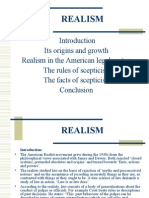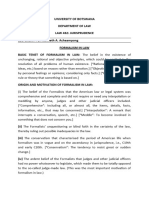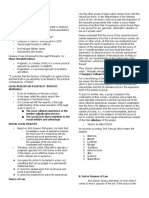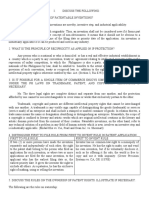MISHAL AKRAM
SECTION(B)
Submitted to :SIR SIKENDAR
ROLL NO:193 JUSRISPRUDENCE-311
1
�CONTENTS:
INTRODUCTION
BACKGROUND OF AMERICAN REALISM
REALISTS VIEW
Oliver Wendell Holmes:
Jerome New Frank
Conclusion
2
� INTRODUCTION:
The word REALISM literally means “the attitude or practice of accepting a
situation as it is and being prepared to deal with it accordingly.” But in
jurisprudence according to the realists “it is defined as realism denounces
traditional legal rules and concepts and focuses more on what the courts
actually do in reaching the final decision in the case. In strict sense, realists
define law as generalized prediction of what the courts will do. Realists believe
that certainty of law is a myth and its predictability depends upon the set of
facts which are before the court for decision in each case” 1. View of nature of
law that legal rules are based on judicial decisions given in interest of the larger
society and public policy, and not on any dogma or supernatural authority. It
defines 'legal rights' and 'legal duties' as whatever the courts say they are.
Background of realism:
Legal realism is a school of legal philosophy that is generally associated with the
culmination of the early-twentieth century attack on the orthodox claims of late-
nineteenth-century classical legal thought in the United States of America.2 Legal
Realism is often remembered for its challenge to the Classical legal claim that
orthodox legal institutions provided an autonomous and self-executing system of
legal discourse untainted by politics. The realist school has been divided into two
parts:
Scandinavian Realism and American Realism Both are hostile to formalism that
treats law as a lifeless phenomenon. Both adopt radical empirical methods that
seek to explain law in terms of observable behavior (examining cause and effect).
Scandinavian Realism is existed in Europe, Sweden, Norway, England and
Scandinavian countries.
1
https://newindialaw.blogspot.com/2012/11/american-realist-school-of-jurisprudence.html?
m=1
2
https://www.lawnotes.in/American_Realism
3
� Realist’s views:
There are many realists who supported and developed the concept of realism
some of the most prominent are as follows:
Oliver Wendell Holmes:
Holmes is a towering figure in realism thought for many reasons, but what the
realists drew most from Holmes was his famous prediction theory of law, his
utilitarian approach to legal reasoning, and his "realist" insistence that judges, in
deciding cases, are not simply deducing legal conclusions with inexorable,
machine-like logic, but are influenced by ideas of fairness, public policy, and other
personal and conventional values.
All these themes can be found in Holmes's famous 1897 essay, "The Path of the
Law". There Holmes attacks formalist approaches to judicial decision making and
states a pragmatic definition of law: "The prophecies of what the courts will do
in fact, and nothing more pretentious, are what I mean by the law". If law is
prophecy, Holmes continues, we must reject the view of "text writers" who tell
us that law”3 it is something different from what is decided by the courts of
England, that it is a system of reason that is a deduction from principles of ethics
or admitted axioms or what not, which may or may not coincide with the
decisions.
Holmes’s understanding of legal realism shows his relationship to the natural law
and natural rights traditions. For Holmes, law and society are always in flux, and
courts adjudicate with an eye to law’s practical effects. Morality has nothing to do
with law it amounts to little more than a state of mind. There are no objective
standards for determining right and wrong and therefore no simply just answers
to legal questions.
Jerome New Frank
3
Oliver Wendell Holmes, Jr., "The Path of the Law," 10 Harvard Law Review 457 (1897).
4
� was an American legal philosopher and author who played a leading role in
the legal realism movement, Chairman of the Securities and Exchange
Commission, and a United States Circuit Judge of the United States Court of
Appeals for the Second Circuit.
To understand the tremendous value of Jerome Frank's realistic legal philosophy
at the time it was written we must go back to the spiritual and economic troubles
of the depression when Law and the Modern Mind appeared. In his book he
discuss that law is not certain its certainty is only a myth. He argued that it is not
the duty of the judge to follow the myth, precedents and conventions of law, their
work is to do some constructive work in each case and shall not follow precedents
blindly and shall act upon which is convenient for the case at present situation.
Conclusion:
Legal realism is a school of thought which differs from philosophical school of
thoughts. It is concerned with the outcome and end of the law. The followers of
this school are called realists and they argue that law Is what is in practice of the
judges and lawyers rather than the laws written in statutes and Acts. There were
many jurists who contributed in the development of legal realism such as Holmes
and frank who argued that a certainty of law is a myth and precedents shall not
be followed blindly by the judges rather the shall contribute in constructive form
of law rather than bookish form of law. The shall be mere practice of the judges
and courts.
--------------------------------------------------------------------------------------------











































































































